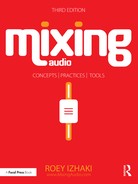Contents
Part I: Concepts and practices
Music: an extremely short introduction
The role and importance of the mix
What makes a great mixing engineer?
Mixing and the production chain
Finalizing and stabilizing the mix
7 Mixing domains and objectives
The importance of signal flow diagrams
Equalizing various instruments
16 Introduction to dynamic range processors
Dynamic range processors in a nutshell
Principle of operation and core controls
Reverb properties and parameters
Pitch shifters and harmonizers
30 “It’s Temps Pt. II” (hip-hop/urban/grime)
Appendix A: The science of bouncing
..................Content has been hidden....................
You can't read the all page of ebook, please click here login for view all page.
